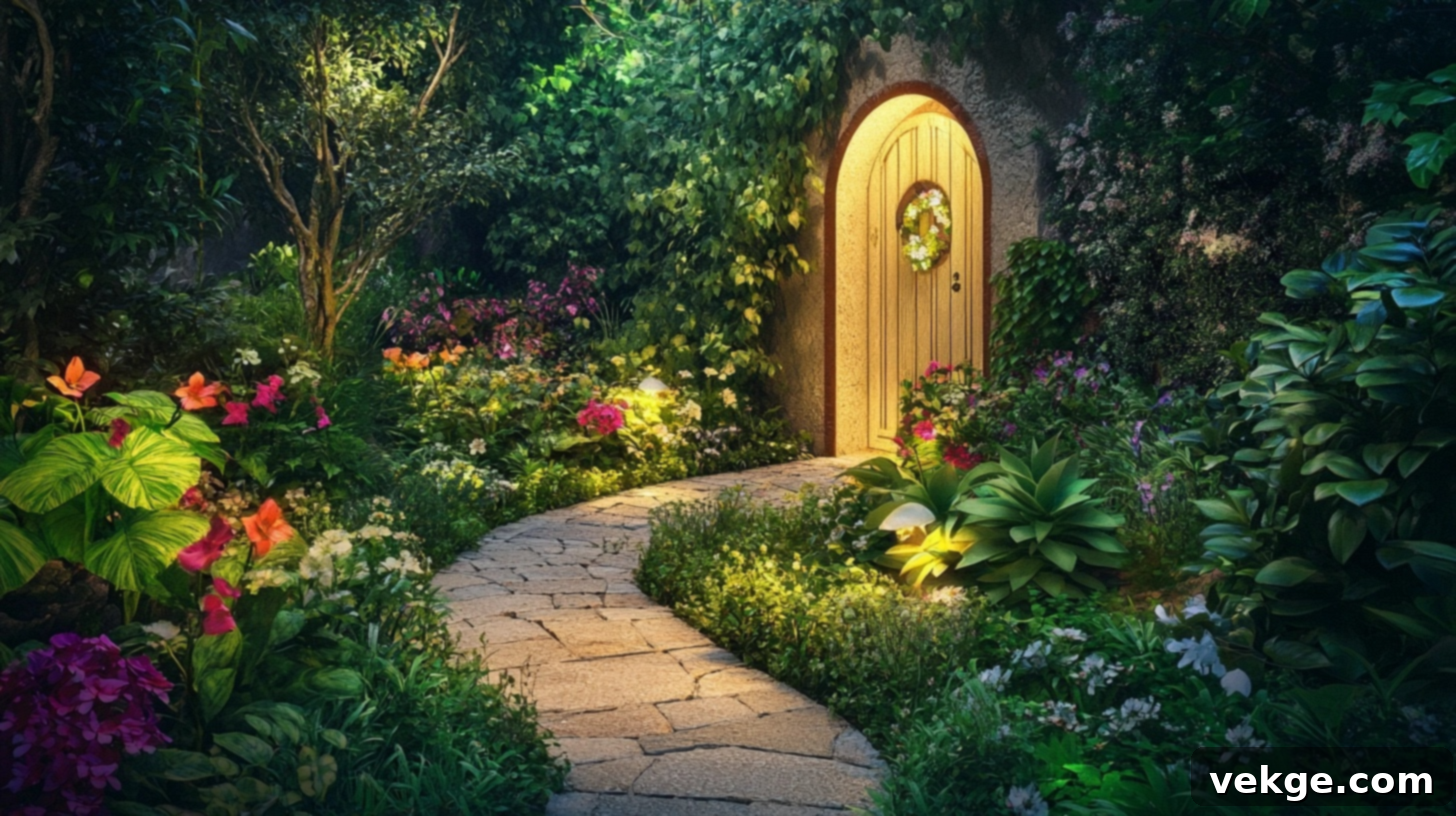Create Your Own Secret Garden: A Comprehensive Guide to Designing Your Private Outdoor Oasis
Have you ever yearned for a private outdoor sanctuary, a peaceful escape from the constant hustle and bustle of daily life? A secret garden offers precisely that—a secluded, enchanting retreat nestled right in your backyard. Unlike conventional open gardens, these hidden havens create a profound sense of mystery, tranquility, and personal connection with nature through their thoughtful design, including enclosed walls, winding pathways, and an abundance of lush plantings.
This comprehensive guide will walk you through the essential components of creating a secret garden, providing practical, step-by-step instructions to help you craft your own hidden haven. Whether you possess a sprawling yard or just a small, overlooked corner waiting to be transformed, you’ll discover how to bring your dream garden to life. From ingenious budget-friendly tips to strategic plant selection, you’ll learn to design and cultivate a personal outdoor space that feels worlds away from the ordinary, offering solace and beauty right at your doorstep.
What is a Secret Garden? Unveiling Your Hidden Retreat
At its core, a secret garden is a private, hidden outdoor space meticulously designed to offer seclusion, peace, and a profound sense of removal from the outside world. These unique gardens boast deep historical roots across numerous cultures, evolving from the practical enclosed courtyards of medieval castles to the more decorative walled English estate gardens, and even philosophical Zen gardens in Japan. What truly distinguishes a secret garden is its inherent hidden quality—it’s not meant to be overtly displayed but rather discovered and savored.
Unlike an open, expansive yard, a secret garden feels like a deeply personal retreat, a sacred spot reserved just for you. It is deliberately shielded from casual view by strategic elements such as solid walls, towering hedges, ornate fences, or dense, layered plantings. The moment you step into a secret garden, you’re enveloped in a different, more peaceful realm, a place where time seems to slow down and worries gently dissipate.
The concept of the secret garden gained widespread recognition and romantic appeal through Frances Hodgson Burnett’s classic 1911 novel, “The Secret Garden.” In the book, the hidden garden serves as a powerful metaphor for healing, growth, and the transformative power of nature and renewed hope. In our contemporary, fast-paced lives, secret gardens serve an invaluable purpose: they are quiet havens where individuals can truly relax, read, meditate, practice mindfulness, enjoy the simple beauty of nature, or simply think without interruption. Their enduring charm stems from the delightful surprise and wonder of turning a corner and finding yourself immersed in a lush, vibrant green space that feels utterly separate from the stresses of everyday existence—a small, personal sanctuary where genuine unwinding and rejuvenation are possible.
Essential Design Ideas for Crafting Your Secret Garden
Creating a truly hidden garden retreat involves incorporating specific features that contribute to both its aesthetic beauty and its crucial sense of privacy and enclosure. Let’s delve into the most important components to consider and include in your secret garden design, ensuring every element works in harmony to build your personal sanctuary.
1. Privacy and Enclosure: The Foundation of Seclusion
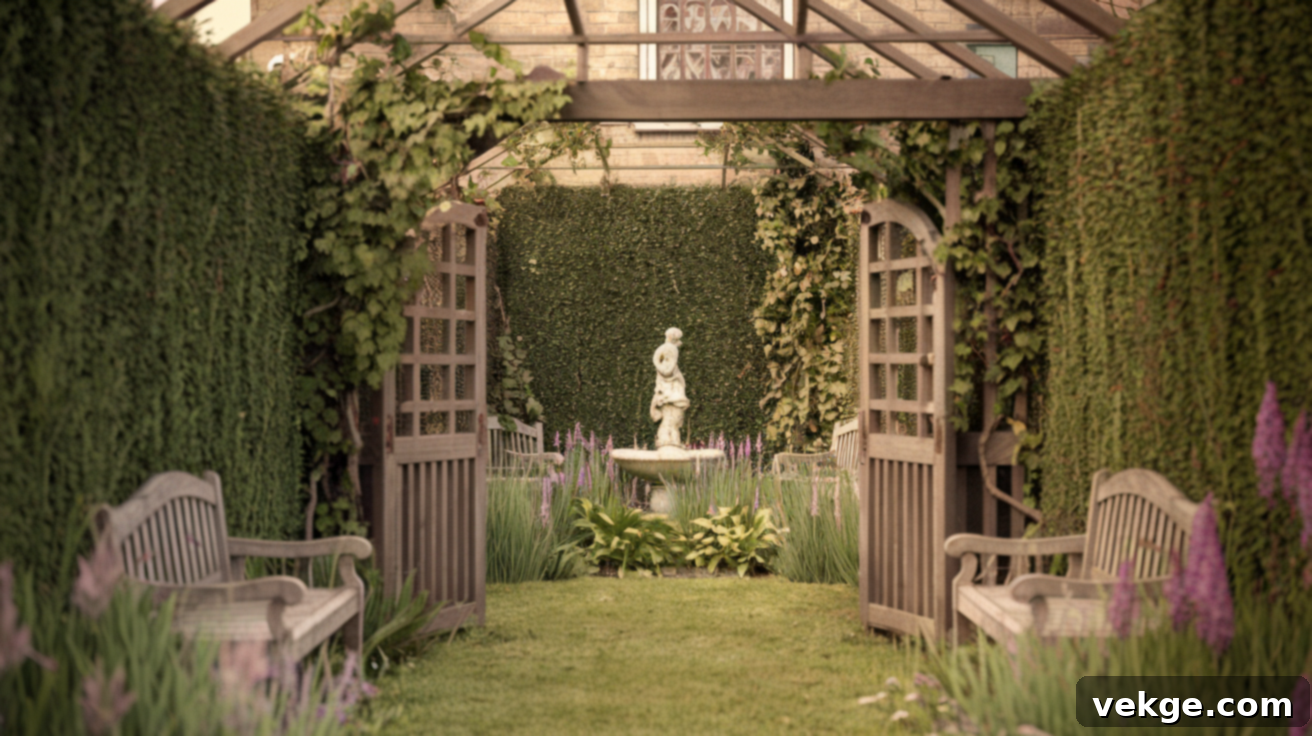
The very essence of any secret garden lies in its profound sense of privacy and seclusion. Establishing clear boundaries is paramount. Walls, whether constructed from stone, brick, or reclaimed materials, offer robust visual and auditory barriers. Tall, dense hedges, such as those made from arborvitae or privet, can form natural, living walls that evolve with the seasons. Arbors and trellises, laden with climbing vines, provide both privacy and an enchanting sense of enclosure, allowing light to filter through while still maintaining intimacy. A carefully chosen vintage gate or a freestanding door makes for an ideal entrance, adding both whimsical charm and a distinct symbolic boundary between the outside world and your hidden, intimate space. This physical and psychological separation is key to cultivating the garden’s mystique.
2. Curved Paths and Winding Trails: A Journey of Discovery

Winding paths that gently twist and turn through your garden are instrumental in building a sense of mystery and encouraging exploration. Unlike straight lines that reveal everything at once, curving trails deliberately hide what lies ahead, creating delightful moments of surprise and discovery as visitors delve deeper into the space. The choice of materials for these paths can greatly enhance the sensory experience. Pea gravel creates a satisfying crunch underfoot, while flagstone or natural stepping stones offer a more organic, rustic feel. Wood chips or bark mulch can provide a softer, quieter surface. These materials not only add visual texture but also guide the eye and the body, leading you on a journey through your personal green labyrinth.
3. Water Features: Sound and Serenity
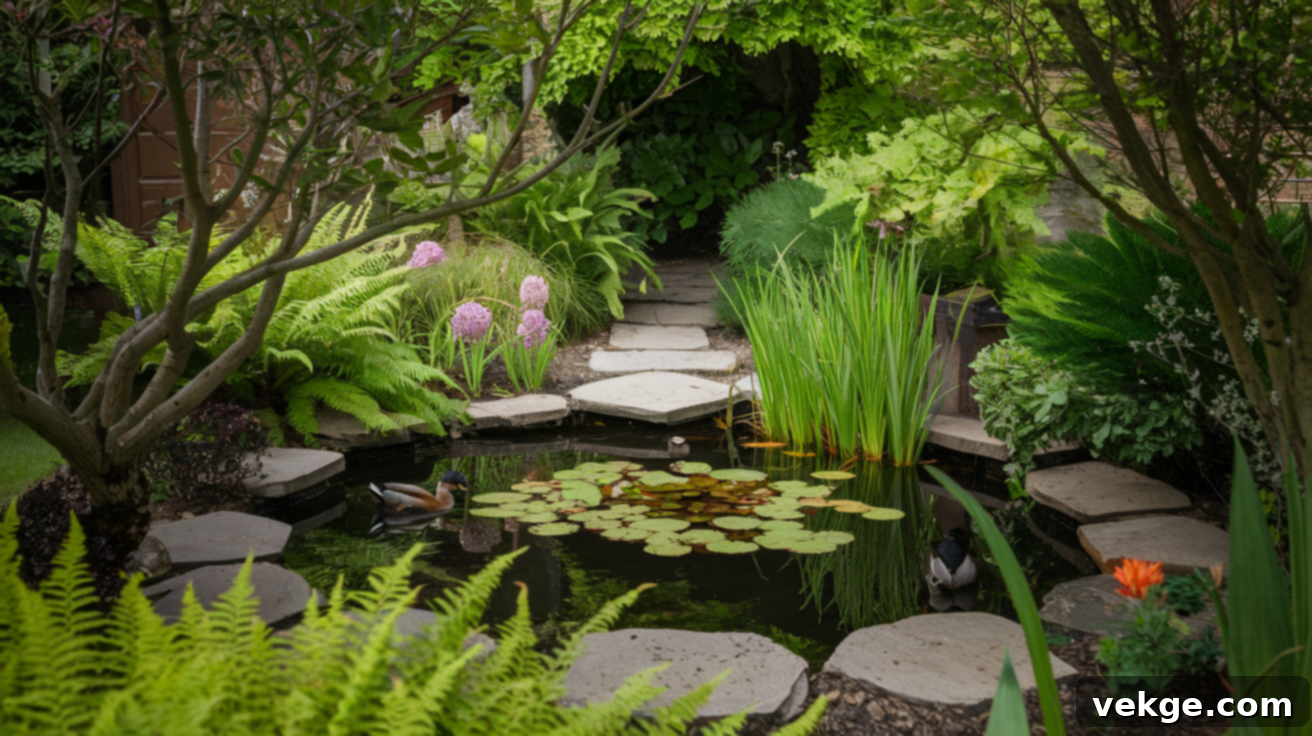
Introducing a water feature can profoundly transform the atmosphere of your secret garden, infusing it with calm and vitality. The gentle sound of flowing or rippling water from a small fountain, a bubbling birdbath, or a miniature pond instantly soothes the senses, masking ambient noises and inviting a sense of peace. Beyond their auditory appeal, water features naturally draw the eye and can serve as captivating central focal points around which the rest of your garden’s design can gracefully unfold. They also attract local wildlife, such as birds and butterflies, adding another layer of natural beauty and movement to your secluded haven. Consider the size and style that best fits your space, from a classic tiered fountain to a minimalist stone bubbler.
4. Seating and Relaxation Areas: Inviting Repose

Every secret garden needs comfortable, inviting places to sit, reflect, and fully immerse oneself in the surroundings. Thoughtfully placed benches, chairs, or even a small bistro table in secluded spots enhance the garden’s functionality and charm. Imagine a quiet bench tucked under the graceful branches of a mature tree, offering shade and intimacy, or a comfortable chair nestled beside a cluster of fragrant lavender or jasmine. A dining area shaded by a leafy pergola or a natural canopy of trees creates a magical “outdoor room,” providing a sense of enclosure and a perfect spot for al fresco meals or quiet contemplation. The choice of seating materials, from rustic wood to wrought iron, should complement the overall aesthetic of your hidden retreat.
5. Lighting Additions: Extending the Magic
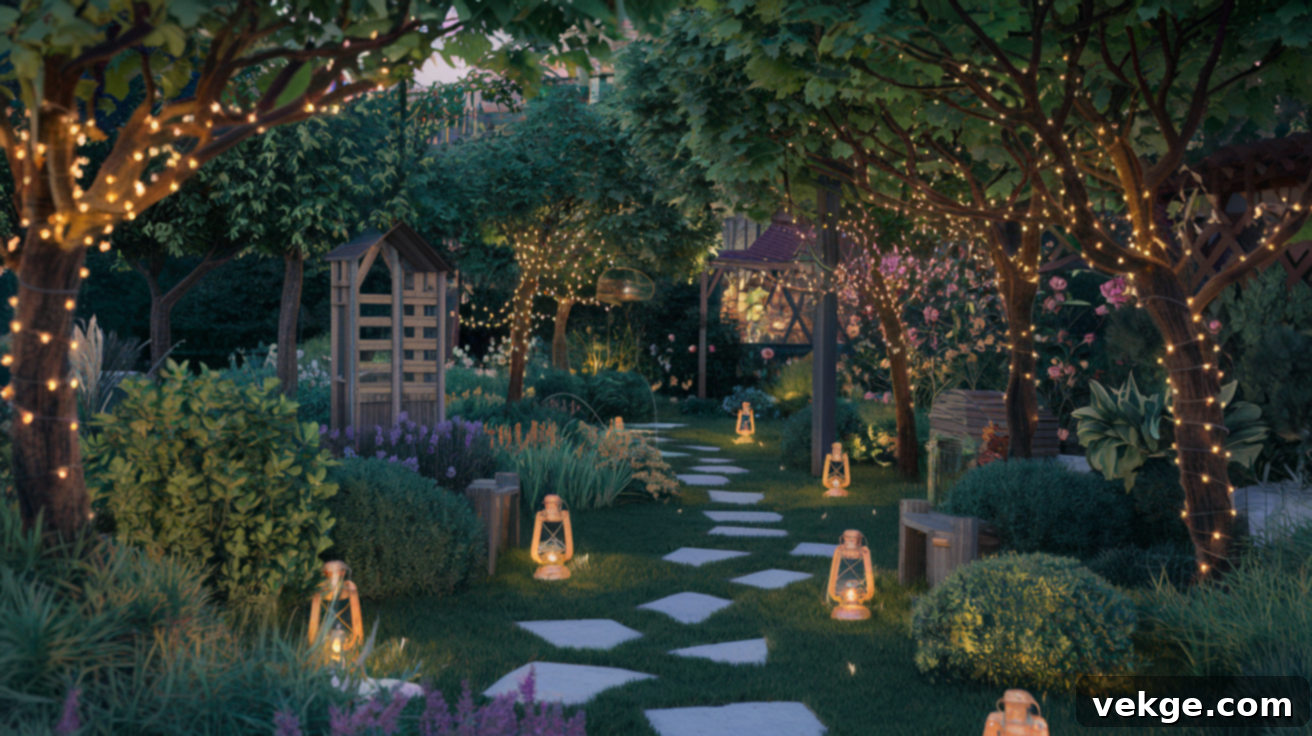
Thoughtful lighting allows you to extend the enjoyment of your secret garden into the evening hours, creating a warm, magical, and inviting mood after dark. There are numerous simple yet effective options to consider. String lights, draped overhead like a canopy, cast a festive and ethereal glow, perfect for creating a starry night effect. Lanterns, strategically placed along pathways or hung from tree branches, provide gentle, ambient illumination that guides the eye and enhances safety. Solar-powered garden lights are an easy and eco-friendly choice for marking the edges of paths, highlighting special plants, or drawing attention to a unique feature. Spotlights can be used sparingly to illuminate a striking statue or a particularly beautiful specimen plant, adding depth and drama to the nocturnal landscape.
6. Freestanding Door: A Gateway to Wonder
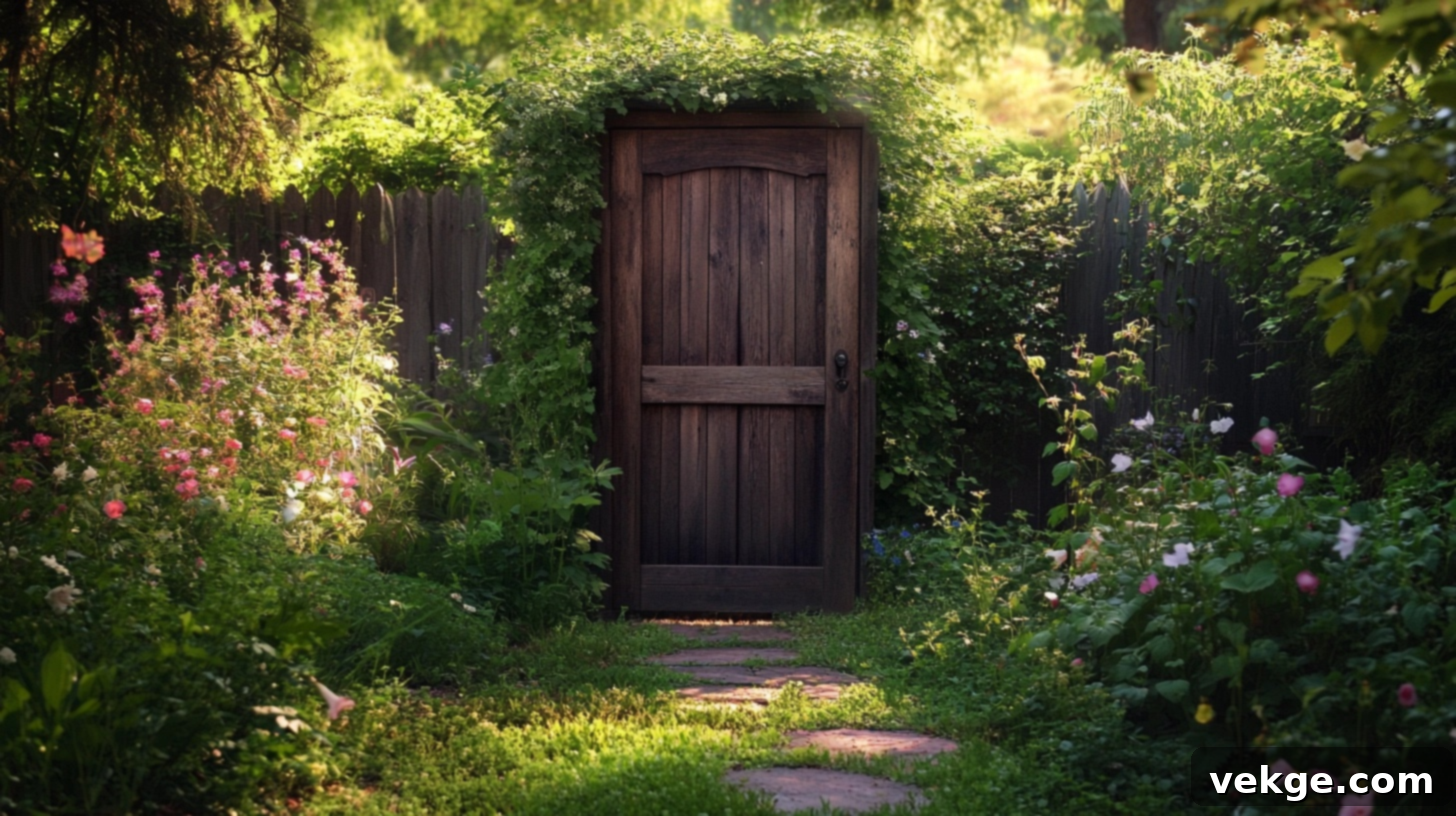
An old, freestanding door, seemingly placed out of context, can serve as an exceptionally charming and whimsical entry point to your hidden garden. This feature transcends mere functionality, becoming a symbol of transition and discovery. Seek out doors with character—weathered wood, peeling paint, or etched glass panels that catch the light—as these imperfections add to their allure. The beauty of a freestanding door is that it doesn’t require actual walls on either side; its very presence hints at stepping into a special, secluded realm. Position it artfully between dense bushes or tall, leafy plants to create the illusion of a true passage. Encourage climbing plants, such as morning glories, wisteria, or climbing roses, to grow around the frame, making the door appear as if it has been there for ages, patiently waiting to be found and opened, inviting you into its secret world.
7. Fragrant Flowers: An Olfactory Delight
Engaging all the senses is crucial for creating an immersive secret garden experience, and adding sweet-smelling plants is key to this. Strategic placement allows you to fully savor their intoxicating aromas. Plant jasmine near seating areas or archways where its rich, heady scent can truly envelop you. Lavender, with its gentle, calming fragrance and beautiful purple hues, is perfect for planting along pathways or near benches. Classic, old-style roses, known for their lush, full blooms and deep, complex perfumes, bring a timeless charm. Other fragrant options include honeysuckle, gardenias, lilacs, and sweet peas. These aromatic plants add a magical, multi-sensensory dimension to your garden, transforming it into a place that appeals far beyond mere visual aesthetics, offering a truly holistic and memorable retreat.
8. Lush, Dense Planting: Creating Living Walls
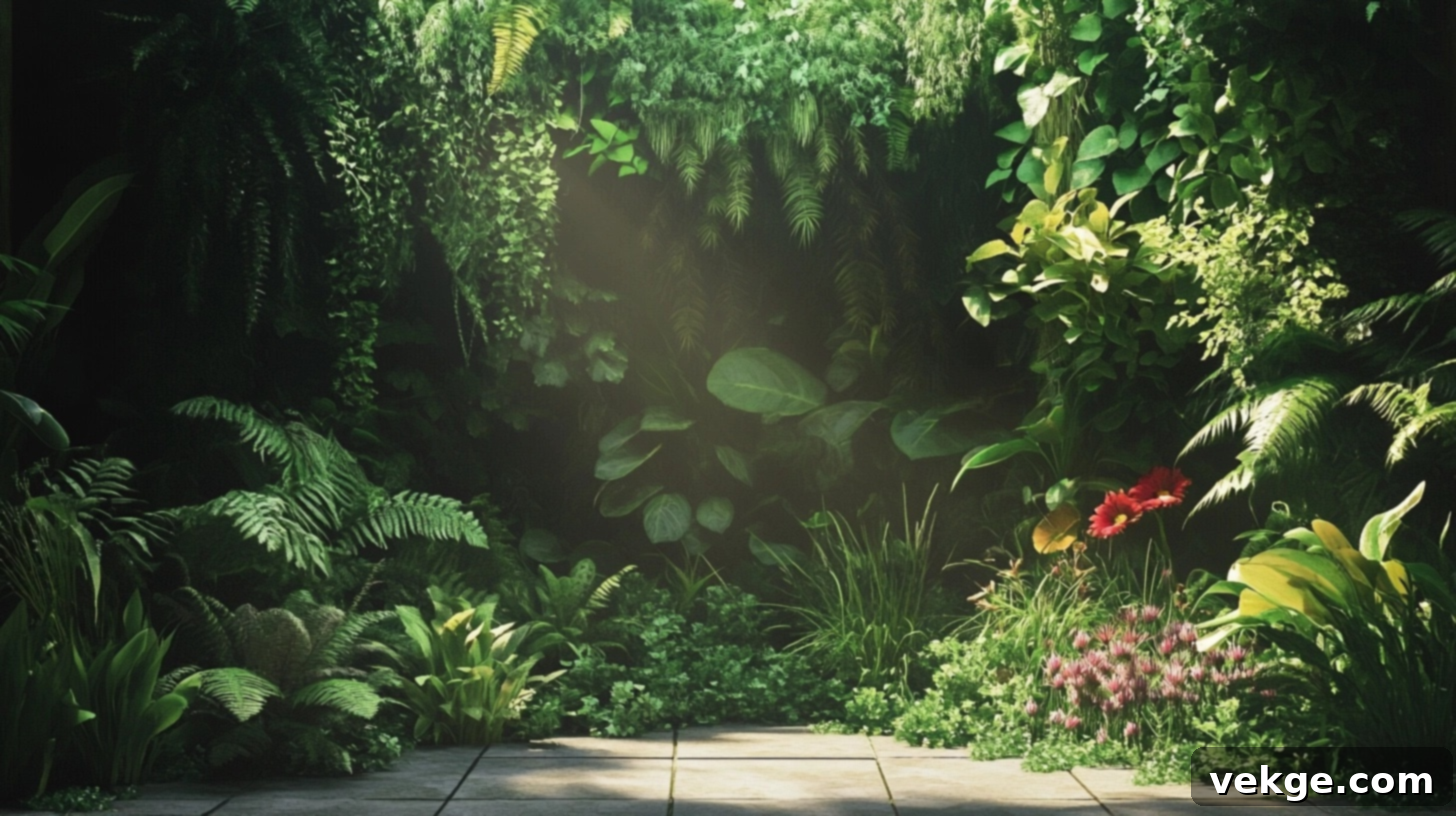
The backbone of any hidden garden is its abundant, dense greenery, which effectively forms living walls and creates a sense of enclosure. The key is to mix plants of varying heights and textures to build layers that block views from the outside and create visual depth. Start with tall shrubs or small trees for the background, then incorporate mid-height perennials and annuals. Ferns, with their delicate, feathery leaves, add soft texture and thrive in shady spots, while ivy can be trained to climb walls or fences, forming lush, green barriers. Consider plants like hostas for broad leaves, or alliums for their striking ball-shaped purple flowers that stand tall among other plants, adding unexpected visual interest. This dense tapestry of foliage transforms even a modest space into a secluded, hidden world, allowing you to feel completely immersed and away from the demands of daily life.
9. Potted Plants and Planters: Versatility and Focus
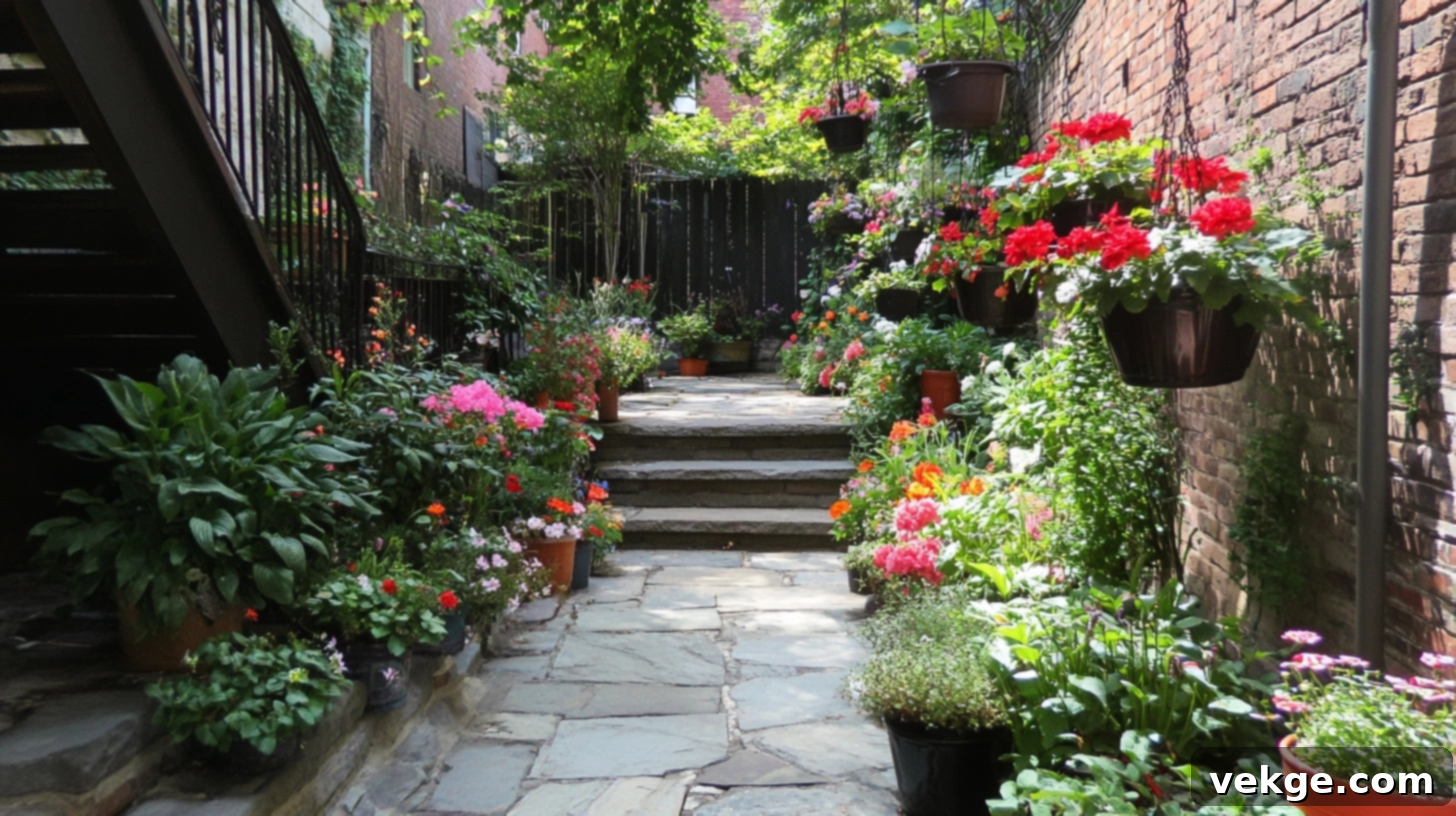
Containers and potted plants offer remarkable flexibility and artistic expression within a secret garden setting. Their mobility allows you to easily rearrange your space as seasons shift, or whenever you desire a fresh look or need to adjust for growth. Hanging plant baskets from tree branches, pergolas, or posts adds vertical interest and draws the eye upward, enhancing the feeling of a lush, multi-dimensional space. Utilize pots of varying sizes, shapes, and colors to create captivating visual interest and define different zones within your garden. For smaller yards or patios, containers are invaluable, enabling you to cultivate a diverse array of plant types in limited square footage, thereby creating a rich, vibrant plant mix without requiring extensive in-ground growing areas. They also allow you to grow plants that might not thrive in your native soil.
10. Wildflower Garden: Natural Beauty and Biodiversity
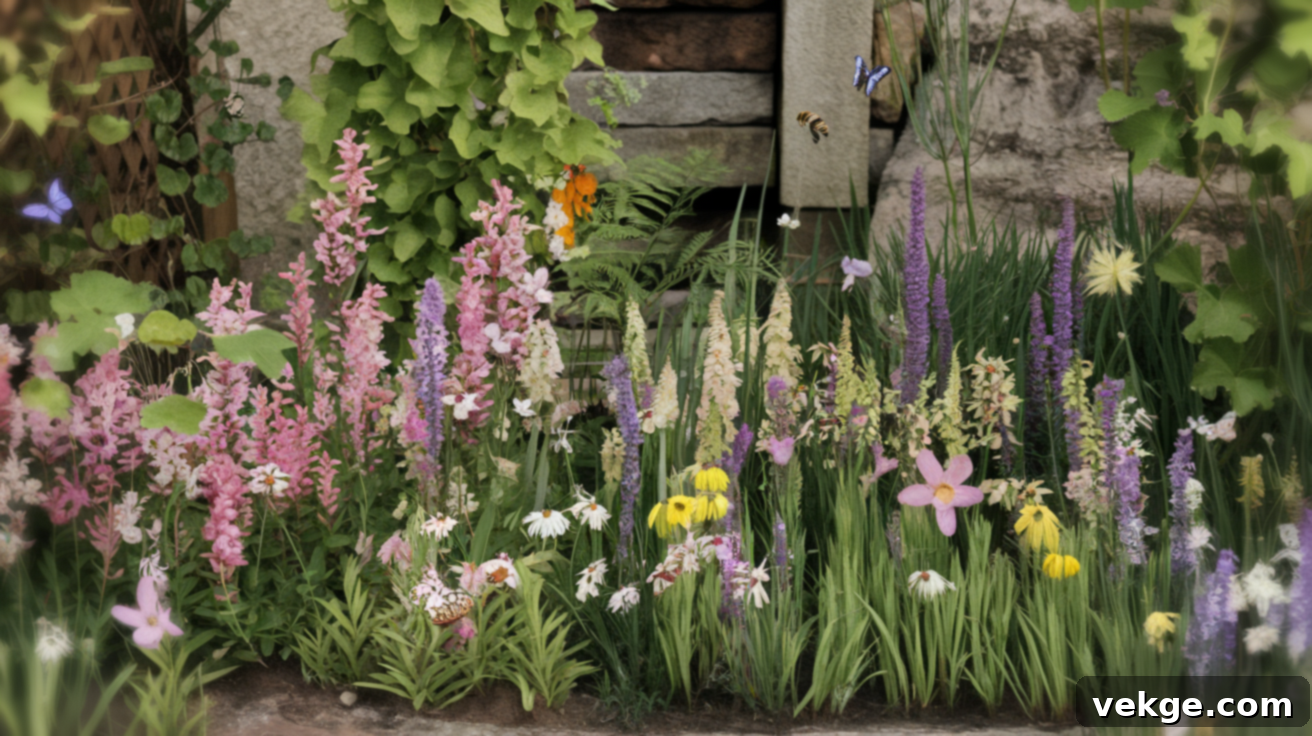
Embrace a touch of untamed beauty by dedicating a patch of your secret garden to wildflowers. Simply scatter a mix of native wildflower seeds and allow nature to take its course as they sprout and grow into a vibrant tapestry of colors and shapes. This informal, naturalistic growing style not only creates a charming, ever-changing landscape but also provides immense ecological benefits. It naturally attracts beneficial insects like butterflies and bees, as well as various bird species, bringing delightful movement and life to your space. The dynamic appearance of a wildflower garden means it never stays the same, with new blooms and colors emerging throughout the seasons, offering unexpected visual treats. This natural method requires significantly less maintenance than formal gardens while consistently looking full, lively, and wonderfully organic, enhancing the secret garden’s wild, undiscovered feel.
11. Upcycled Furniture: Character and Sustainability
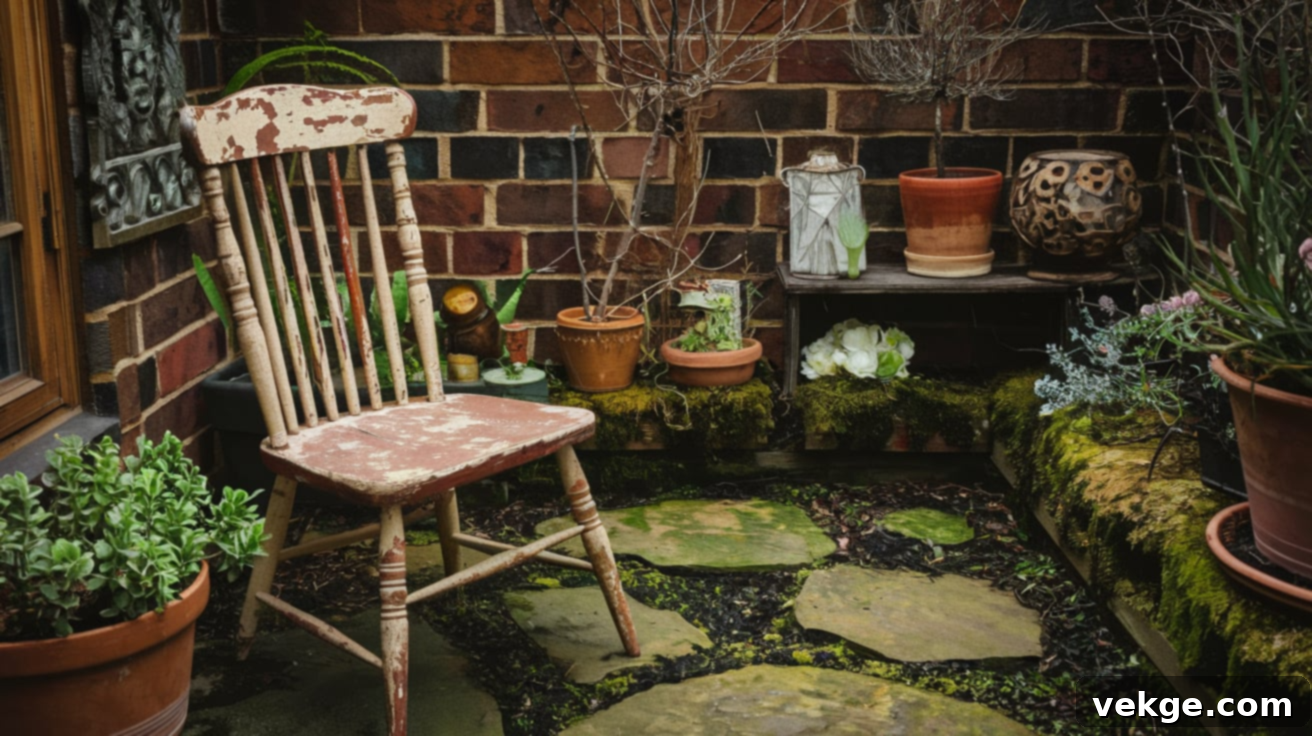
Give old, forgotten furniture pieces a new lease on life by incorporating them into your secret garden. An antique wooden chair with gracefully peeling paint isn’t just a place to sit; it can become a charming plant stand or a decorative accent. Old metal bed frames can be creatively repurposed as unique garden borders, whimsical trellises for climbing vines, or even as sculptural elements. Look for items that bear the marks of time—a touch of rust, faded paint, or a hint of moss growth—as these signs of age only add to their unique appeal and contribute to the garden’s sense of history and charm. Using upcycled items not only offers a highly budget-friendly solution but also infuses your garden with a deeply personal character, a soulful depth, and an eco-conscious ethos that brand-new items simply cannot replicate. Each piece tells a story, making your secret garden truly one-of-a-kind.
Designing a Secret Garden: A Step-by-Step Process
Bringing your secret garden to life requires thoughtful planning, creative design, and careful execution. Here’s a comprehensive, step-by-step process to guide you in transforming your yard into this deeply personal and hidden retreat.
Step 1: Planning Your Layout – The Blueprint for Your Oasis
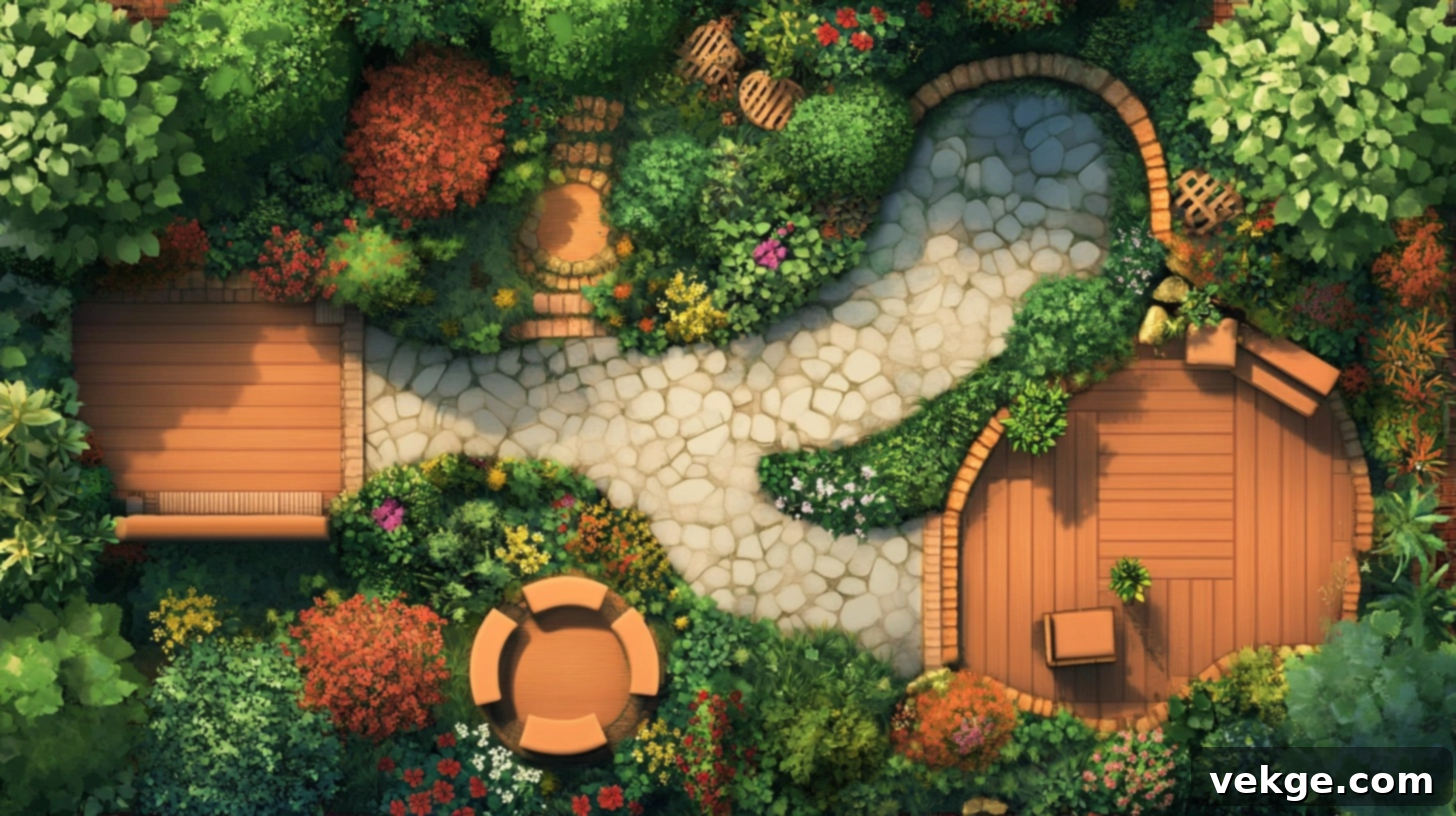
Begin your secret garden project by thoroughly walking your property. Identify areas that naturally offer seclusion or spaces that can be easily screened from view. Consider forgotten corners, areas behind existing sheds, or even alongside a fence line. Measure this chosen area meticulously and create a detailed sketch or diagram. This blueprint should include both hardscape elements—such as pathways, seating areas, and potential water features—and specific planting zones. Think about how you will move through the space; mark clear entrances, winding paths, and specific locations for relaxation or contemplation. Crucially, observe the sun exposure throughout the day in different seasons. This will be the primary factor in determining which plants will thrive in specific spots, ensuring your garden remains lush and healthy. Also, consider existing utilities and drainage patterns.
Step 2: Choosing the Right Plants – Layering for Lushness and Privacy
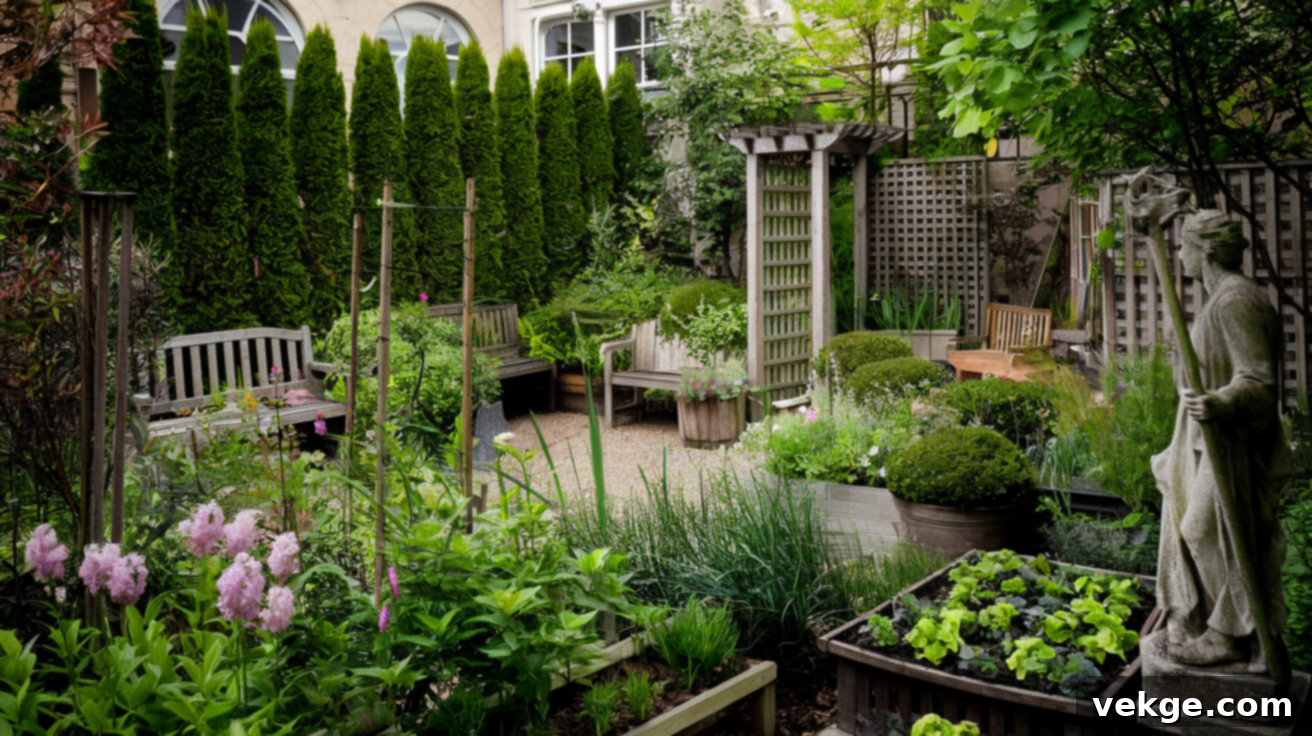
Plant selection is fundamental to creating the lushness and privacy characteristic of a secret garden. Focus on creating multiple layers of greenery. Start with taller background plants like fast-growing arborvitae, dense holly, or bamboo (in contained planters to prevent spreading) to form living walls around the perimeter. Next, add mid-height shrubs, such as hydrangeas, rhododendrons, or camellias, to fill the middle layer and provide seasonal interest. For shady spots, choose ground covers like hostas, ferns, or ajuga. Don’t forget climbing plants like clematis, wisteria, or ivy to cover walls, trellises, and arbors, adding vertical greenery and further enhancing the sense of enclosure. Critically, include at least three types of fragrant plants—such as jasmine, lavender, and old garden roses—positioning them strategically near seating areas or entryways where their delightful scents can be fully enjoyed and create an immersive sensory experience.
Step 3: Adding Decorative Features – Personal Touches and Focal Points
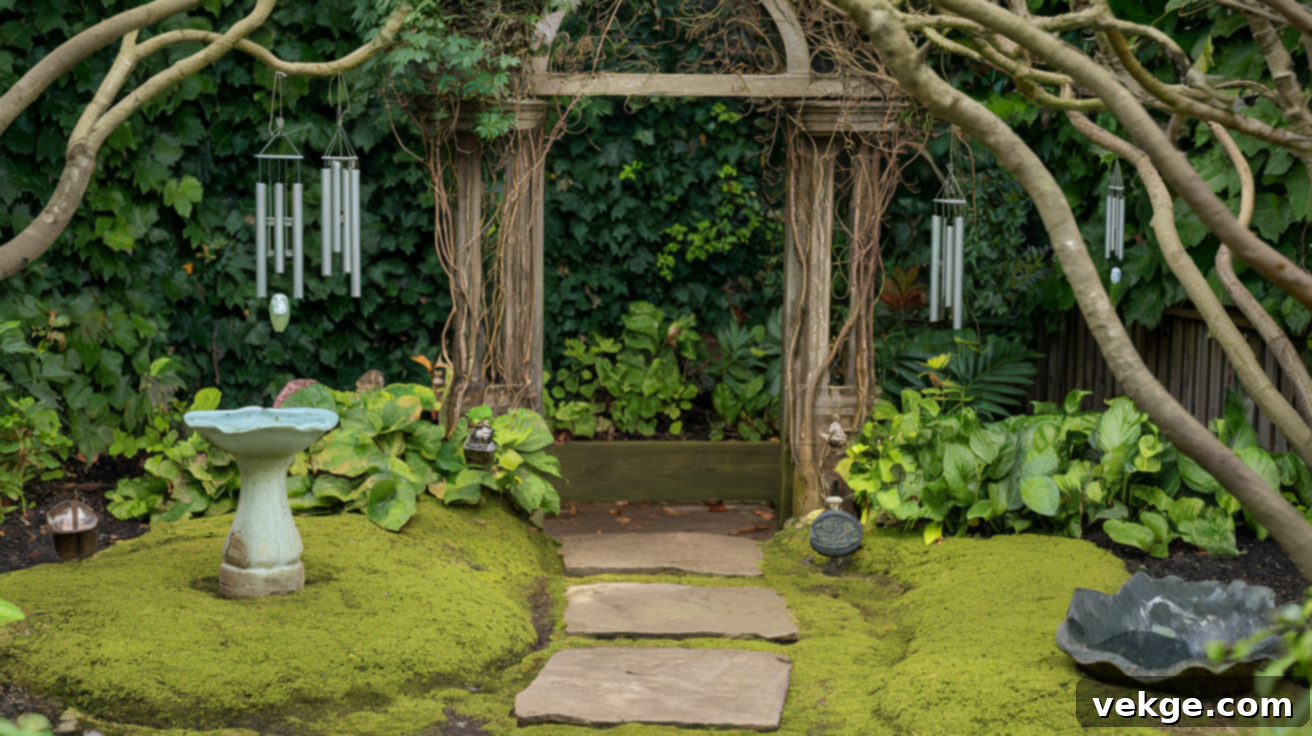
Personalize your secret garden by incorporating meaningful and visually appealing decorative elements. Install an eye-catching entrance feature, such as a weathered wooden gate with ornate hinges, an archway covered with fragrant flowering vines, or even a whimsical freestanding door. Place a focal point—perhaps a graceful small statue, an antique sundial, a stone bird bath, or a unique piece of garden art—at the end of a winding path or in a central clearing, creating a visual destination that draws the visitor deeper into the garden. Hang delicate wind chimes from tree branches to introduce a gentle auditory element, adding to the garden’s serene atmosphere. Position several large planters of varying heights and materials, grouped together, to create visual interest and define key points or transitions within the garden. These elements should reflect your personal taste and contribute to the overall magical ambiance.
Step 4: Incorporating Water Features – Soothing Sounds and Serenity
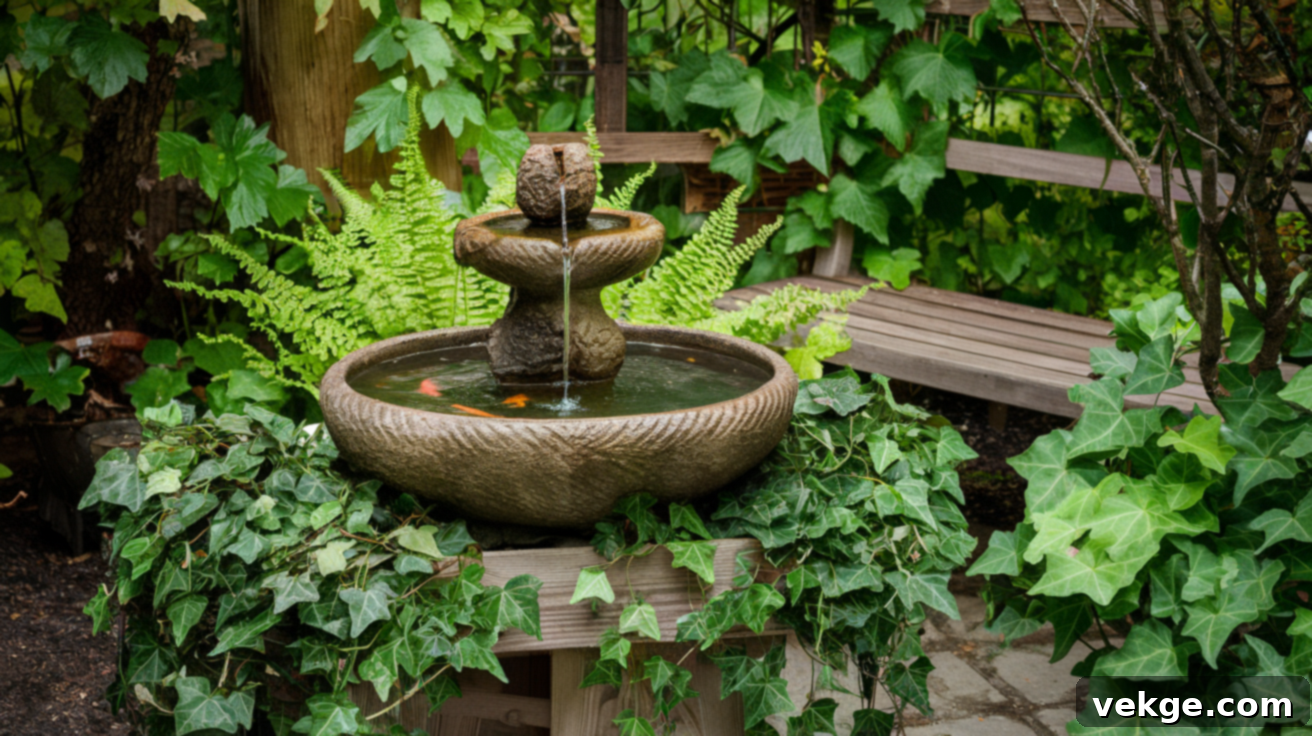
Introducing a water feature can dramatically enhance the tranquility and sensory experience of your secret garden. Choose an option that perfectly aligns with both your space constraints and your maintenance preferences. For a permanent solution, a small pre-formed pond kit can be installed over a weekend; simply dig a hole to the appropriate depth and follow the manufacturer’s instructions for lining and pump installation. If you prefer less commitment or have a smaller space, consider a tabletop fountain that conveniently plugs into an outdoor outlet, or a solar-powered birdbath bubbler that requires no wiring at all. Position your chosen water feature where its soothing sounds can be easily heard and appreciated from your primary seating areas. Ideally, locate it with some shade to help reduce algae growth and keep the water cooler, ensuring it remains a clear and inviting element.
Step 5: Lighting for Ambiance – Illuminating the Night
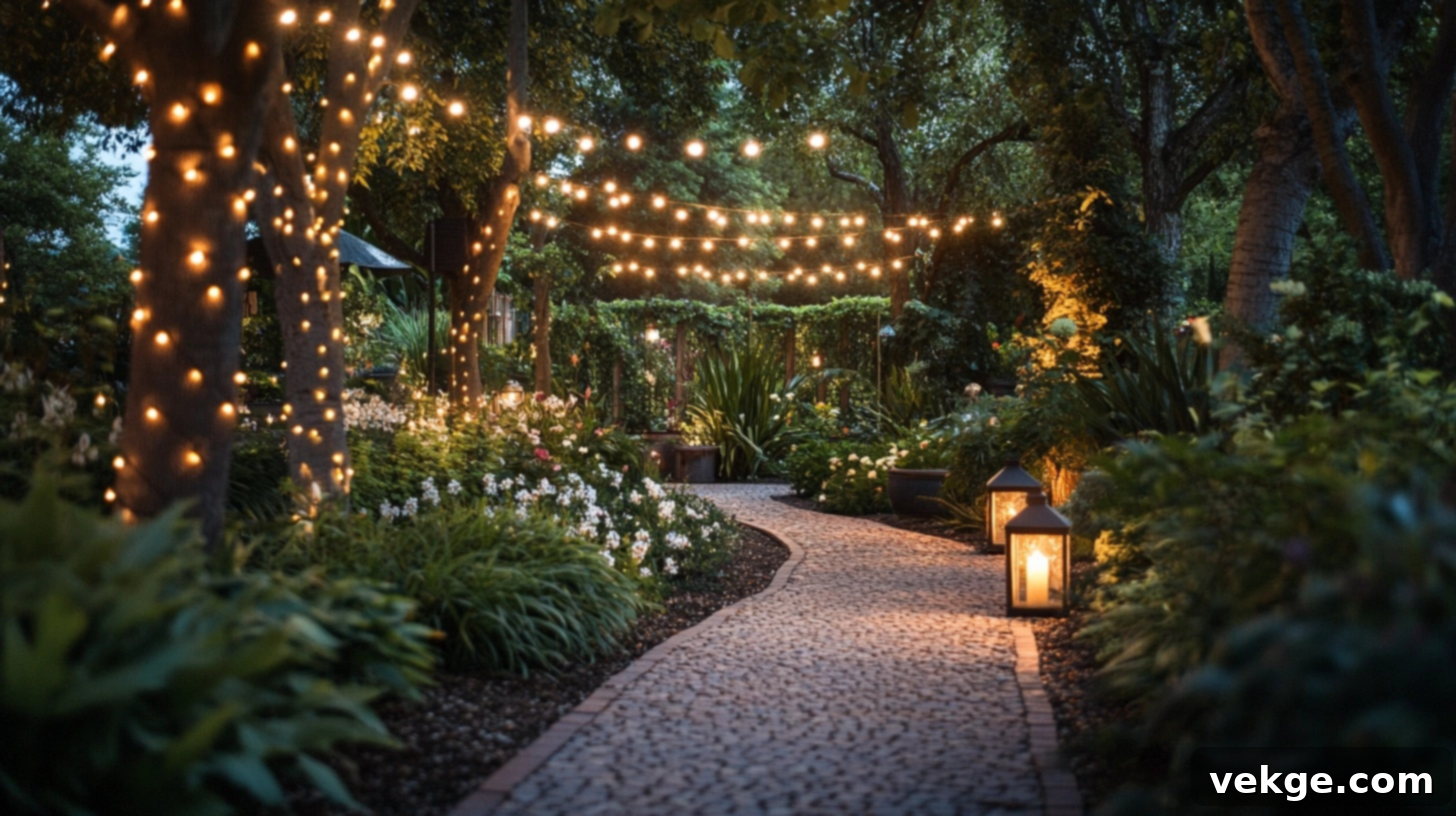
Complete your secret garden’s transformation with carefully placed lighting that extends its beauty and functionality into the evening hours. Install low-voltage landscape lighting along paths for safety and to guide movement, ensuring fixtures direct light downward to reduce glare and create subtle illumination. Wrap weatherproof string lights around tree trunks and through overhead branches to create a truly magical, starry canopy effect that instantly transforms the atmosphere. Place several solar lanterns on tables, hang them from shepherd’s hooks, or scatter them amongst plants to provide gentle, diffused pools of light. Finally, use one or two discreet spotlights to highlight special garden features, such as a beautiful statue, a vibrant specimen plant, or a unique architectural element, angling them carefully to avoid shining into seating areas or neighboring properties. This thoughtful lighting design will invite you to enjoy your secret garden long after sunset.
Budget-Friendly Ideas for Creating a Secret Garden
You absolutely do not need deep pockets to conjure a magical hidden garden retreat. With a bit of clever shopping, resourcefulness, and a willingness to embrace simple DIY projects, you can build a beautiful, private secret space on even the most modest budget. The key is to think creatively and embrace the charm of repurposed materials and natural elements.
Start your treasure hunt at yard sales, flea markets, thrift stores, and online marketplaces like Facebook Marketplace or Craigslist. Old wooden doors, windows, or sections of fencing can be repurposed to form charming garden walls or unique entrances. Instead of costly natural stone pavers, use inexpensive concrete stepping stones, or even create your own with DIY molds. For paths, consider budget-friendly options like wood chips, bark mulch, or gravel. You might even find free materials by asking local tree removal services for wood chips.
When it comes to plant material, focus on perennials that return year after year, offering long-term value. Connect with local gardening groups or ask fellow gardeners for divisions from their established plants – many will happily share excess hostas, daylilies, or sedum for free. Fast-growing annual seeds, such as morning glories, nasturtiums, or sweet peas, provide quick, inexpensive coverage and can transform an empty space in a single season. For vertical elements, build your own trellises using readily available bamboo poles and garden twine, or construct a simple wooden frame with chicken wire for climbing plants.
Seating can be created from reclaimed items; a sturdy cushioned board placed across cinder blocks makes a surprisingly comfortable bench, or an old, forgotten bench can be refreshed with a coat of outdoor paint. For water features, a simple solution involves burying a large plastic container (like a utility tub) in the ground, adding a small recirculating pump, and then hiding the edges with collected stones, pebbles, and water plants. Evening illumination can be achieved with budget-friendly solar garden lights from discount stores, while repurposed glass jars with tea lights or battery-operated fairy lights create a warm, intimate glow for pennies. By embracing these innovative and budget-conscious approaches, your secret garden can still possess all the charm, mystery, and privacy you desire without the high price tag of pre-made or high-end garden elements.
Secret Garden Maintenance Tips: Keeping Your Oasis Thriving
A well-maintained secret garden continues to provide that cherished feeling of escape, beauty, and privacy throughout the year. Regular care ensures its lushness, health, and enduring charm. Here are essential tips to keep your hidden haven thriving:
- Weekly Checks: Make it a habit to walk through your garden at least once a week. This allows you to spot issues early, such as pests, diseases, or plants needing water, before they become major problems.
- Prune Regularly: Trim back overgrown plants, shrubs, and vines to maintain clear pathways, preserve your desired design, and encourage healthy growth. Deadheading spent flowers also promotes new blooms.
- Mulch Heavily: Apply a 2-3 inch layer of organic mulch (such as wood chips, bark, or compost) to all planting beds. This helps retain soil moisture, suppress weeds, moderate soil temperature, and improve soil health over time, significantly reducing your watering and weeding efforts.
- Water Deeply, Less Frequently: Instead of light, daily sprinkles, give your plants thorough, deep soakings. This encourages roots to grow deeper, making plants more resilient to dry spells. Adjust frequency based on weather and plant needs.
- Feed Appropriately: Use a slow-release granular fertilizer for most plants, following package directions to avoid over-fertilization. For specific plants like roses or annuals, targeted liquid feeds might be beneficial. Soil tests can help determine exact nutrient needs.
- Remove Spent Flowers (Deadhead): Regularly deadhead flowering plants by removing faded or spent blooms. This redirects the plant’s energy into producing more flowers rather than setting seed, resulting in a longer and more abundant blooming season.
- Inspect Structures: Annually, preferably each spring, inspect all hardscape elements such as trellises, arbors, gates, benches, and pathways for any signs of wear, rot, rust, or instability. Address needed repairs promptly to ensure safety and longevity.
- Clean Water Features: Weekly, remove any floating debris like leaves or petals from fountains or ponds. Perform a deeper cleaning monthly, which may involve scrubbing algae and checking pump filters, to maintain water clarity and feature functionality.
- Control Climbing Growth: Keep a watchful eye on climbing plants and vines. While they are essential for creating enclosure, ensure they enhance structures without overwhelming or damaging them. Guide their growth and prune as needed.
- Seasonal Clean-up: Conduct thorough seasonal clean-ups. In autumn, clear fallen leaves and spent annuals to prevent disease and fungal growth over winter. In spring, remove any winter damage and prepare beds for new growth.
- Pest and Disease Management: Regularly check plants for signs of pests or diseases. Address minor infestations with organic solutions like insecticidal soap or neem oil. Good air circulation and proper plant spacing can help prevent many issues.
For year-round visual interest and appeal, include a diverse selection of plants that shine in different seasons. Consider spring bulbs like daffodils and tulips for early color; summer perennials such as vibrant roses, fragrant lavender, and cheerful coneflowers; fall standouts like ornamental grasses, chrysanthemums, and late-blooming asters; and winter structural plants with interesting bark textures, colorful berries, or evergreen foliage like holly or conifer varieties. This thoughtful planning ensures your secret garden remains a beautiful and engaging sanctuary no matter the time of year.
Conclusion: Your Personal Oasis Awaits
Creating a secret garden is more than just a landscaping project; it’s a journey of transforming an ordinary yard into a deeply personal hideaway where you can genuinely relax, rejuvenate, and reconnect with the calming rhythm of nature. By thoughtfully incorporating elements like privacy walls, inviting winding paths, comfortable seating, and your own special decorative touches, you’re building far more than just a garden—you’re crafting a unique, private space that profoundly reflects your personality and deepest desires for peace.
Don’t feel overwhelmed by the scope; simply start small. Even dedicating a single, often-overlooked corner of your yard can be the beginning of something truly magical. Nurture your vision, allow your creativity to flourish, and watch as your hidden garden grows and evolves into an extraordinary space that brings immense joy, profound calm, and an enduring sense of wonder to your life. The time and effort invested in planning and building this personal sanctuary will be richly rewarded by the countless peaceful moments and cherished memories you’ll create within its secluded embrace.
